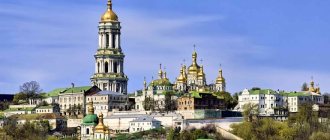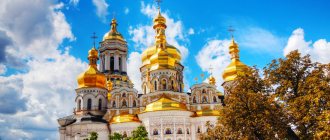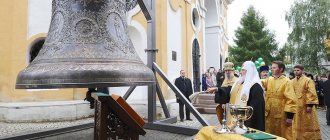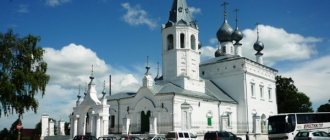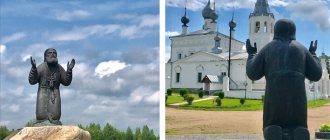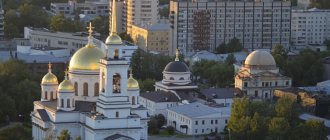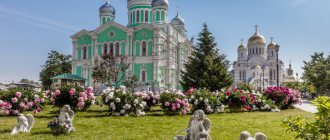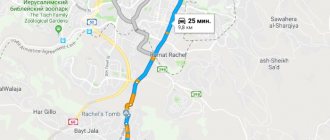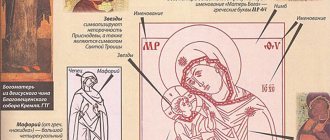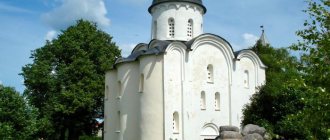The Kiev Pechersk Lavra is a particularly revered religious complex with important historical and spiritual significance. On the territory of Ukraine there are only three laurels consecrated in honor of the Dormition of the Virgin Mary, and this monastery is one of them. However, the value of the Orthodox shrine is recognized not only in its homeland - in 1990, UNESCO included the monastery on the World Heritage List.
Pilgrims know that the Lavra is considered the third Destiny of the Mother of God. This is the name given to the land that is under the special protection of the Mother of God. In addition, the building is one of the first monasteries of Ancient Rus'.
The history of the future shrine began in 1051 and is closely connected with the monks Anthony and Theodosius, who settled in the caves. Over time, the number of their followers increased, and then the monks decided to build cells and the Church of the Assumption of the Blessed Virgin Mary. The monastery grew and soon turned into a monastery. The religious complex began to be called “Pechersky”, which in Old Russian meant “cave”.
The monastery was besieged and robbed more than once. The Lavra suffered from raids by the Polovtsians, Torks, and Mongol-Tatars. In 1596, the Uniates unsuccessfully tried to capture it. The following centuries were no less rich in sad events. The monastery suffered many vicissitudes during Soviet times: the brethren were shot, the complex was liquidated, and then turned into a police station. In 1941, the German occupiers blew up the Assumption Cathedral.
The revival of the monastery began in June 1988. Currently, the Lavra is divided into two parts: the Lower one is under the jurisdiction of the UOC (Ukrainian Orthodox Church), and the Upper one is part of the historical and cultural reserve.
© Liubov Tukalo
Saints and caves of the Holy Dormition Kiev-Pechersk Lavra
The religious building has a developed cave network, which connects with the Kyiv catacombs. The total length of the underground labyrinths is almost 600 meters, and the depth is from 10 to 15 meters. In turn, caves are usually divided into two zones: Near or Antoniev and Far or Feodosiev. On their territory there are Holy relics and Holy springs.
Nearby caves
The neighbors were founded by the same Anthony, whom we discussed above. Today you can see the relics of the saint here - they are kept in a fenced compartment not far from the church in his honor. Next to the remains of the ascetic there is the crypt “Batiem killed”.
79 saints found peace forever in underground rooms. Among them are the incorruptible remains of the monk and author of “The Tale of Bygone Years” Nestor the Chronicler, the mosaicist and icon painter Alypiy of Pechersk, and the hero Ilya of Muromets. According to legend, it was the angels who brought the body of the epic hero here.
Attentive visitors to the Near Caves will notice the windows of the hermits built into the wall. Unfortunately, their current state differs from their original state - they have changed as a result of alterations. Pay attention to the cast iron floor. The slabs were made in 1830 in Tula.
Far Caves
They received their second name thanks to Theodosius, who was buried in one of the underground cells. Unfortunately, no one now knows their exact location. There is a version that the remains are buried in the Assumption Cathedral. But the ascetic’s monastery was identified and discovered in 1988. Next to the premises is the largest underground church of the Kiev Pechersk Lavra - Feodosia.
The most ancient underground structure of the complex is considered to be the Church of the Annunciation of the Blessed Virgin Mary. The list of buildings is completed by the Church of the Nativity.
Opposite the religious building are the relics of nameless Orthodox saints, nicknamed the myrrh-streaming heads. In other crypts and shrines, the remains of 49 canonized saints found their final resting place.
Transition to the Far Caves, © Anna Kudryavtseva
Holy Vikings
In the very center of ancient Kyiv, a crowd is noisy. Warriors, close associates of the prince, ordinary townspeople and, of course, priests - servants of the ancient Russian gods - Perun and Veles. People surrounded a strong wooden house and angrily shouted something to the owner standing in the doorway, but did not dare to approach. They know too well what he is capable of with a sword in his hands.
The owner of the house, Tur, himself comes from the Vikings, or, as they were then called, Varangians - stern warriors from the cold shores of the Baltic Sea. Accustomed to fighting since childhood, they did not value their own lives in battle, terrifying their enemies with their desperation. And now, no matter how angry the besiegers were, no one dared to approach the entrance to the house.
And the reason for their rage is that the prince’s warrior and skilled warrior did not even go against the prince... Against the gods!
Of course, recently more and more Christians have begun to appear among the residents of Kyiv; even the grandmother of the current Prince Vladimir, Princess Olga, was a Christian. And the prince’s brother, they say, also believed in Christ. But now the pagan faith, which had been weakened, is gaining strength again! Prince Vladimir himself had a hand in this. On his orders, an idol of the supreme god Perun was erected in the center of the city, and the priests started talking about old traditions: it was time to truly appease the gods and sacrifice a person to them.
The chronicle has preserved to this day the story of that event: “And the elders and boyars said: “We will cast lots on the youths and maidens; on whomever it falls, we will slaughter him as a sacrifice to the gods.”
The lot fell to the son of the prince's warrior, the Varangian Tur. Everyone expected that he would not oppose such a decision. The Varangians especially reverence the gods; their gods, Thor and Odin, are warlike and merciless. The same is required of everyone who worships them. Therefore, no Varangian will refuse such an honor - to sacrifice his heir if the gods demand it...
But when he heard that his son, John, had been given the lot, Tur just laughed:
- These are not gods, but a tree. Today it exists, but tomorrow it will rot. There is only one God. He created the heavens and the earth, the stars, the moon and the sun. He also created man and destined him to live on earth. What did these gods do? They themselves are created. I will not give my son to demons.
What a news! Is the fearless Varangian warrior really a Christian? Of course, he lived for a long time in Byzantium, served there in the army of the emperor, where many Varangians converted to Christianity... But somehow I still can’t believe it. Although there is no reason to be surprised: after all, Tur adopted a new, Christian name - Theodore, and even baptized his son with the Christian name John.
Martyrdom of Saints Theodore Varangian and his son John
The crowd goes to storm. Once, twice... But the father with a sword in his hands does not allow the attackers to approach his son. Who here said that Christianity is the faith of weaklings? Theodore decided to sacrifice himself: either protect his son, or die with him. And in a fair fight it was not easy for him to defeat even the crowd.
I had to use a trick... Theodore's house stood on pillars. The enemies cut them down, and the house collapsed, burying two Varangians - father and son, who became the first Christian martyrs of Rus'.
Where was the Kiev prince Vladimir at that time? Nothing is known about this. But the heroic death of his faithful warrior, who did not hand over his son to be torn to pieces by the priests, probably shocked the prince. More and more often, the prince began to think about choosing a different faith, about refusing bloody sacrifices. However, another ten years passed before this choice was made. Prince Vladimir himself was baptized, and then he personally cut down the idol of Perun, throwing it into the Dnieper. At the site of the death of Theodore and John, as a sign of repentance, he built the first church in Kyiv, called Tithes...
At the beginning of the twentieth century, excavations were carried out in the city center. Kyiv was destroyed many times, the city burned - from the time of Prince Vladimir, almost nothing even of stone buildings has survived. The Church of the Tithes also disappeared. But archaeologists found the destroyed foundation of that simple wooden house on pillars preserved.
Maybe it's a coincidence, or maybe something more. After all, the relics of his owners, the Viking saints Theodore and John, also rest to this day in the caves of the Kyiv Lavra.
Holy Equal-to-the-Apostles Prince Vladimir
Metropolitan and brethren of the Kiev Pechersk Lavra
The very first abbot of the future shrine was Theodosius, the second founder of the monastery. It was he who introduced the communal rules, was involved in the improvement of cells for the brethren, and also performed other duties. Among the abbots of the monastery who made a significant contribution to its development are also Archimandrite Ignatius, Nikon, Varlaam, Stefan.
The list of outstanding clergy is continued by Archbishops Juvenaly, John, Anthony, Metropolitans Varlaam, Joasaph, Timothy, and Viceroy Hilarion.
During the fight against the union, the Lavra was led by Innocent Gisel, Zacharia Kopystensky, Peter Mogila and Nikifor Tur.
Currently, Metropolitan Onuphry (in the world Orest Vladimirovich Berezovsky) is considered the primate of the Ukrainian Orthodox Church and holy archimandrite. Enthronement took place in August 2014.
Since March 30, 1994, Metropolitan Pavel (Peter Dmitrievich Lebed) has served as vicar here.
Yuri Dolgoruky is buried here, © Anna Kudryavtseva
Abbots and governors
- St. Anthony (before 1032 - ?)
- St. Varlaam (1052 - 1062)
- St. Theodosius (1062 - May 3, 1074)
- St. Stephen (1074 - 1078)
- St. Nikon (1078 - 1088)
- John I (1088 - 1103)
- St. Theoktist (1103 - January 12, 1112)
- Prokhor (February 9, 1112 - 1124)
- Timothy (1124 - 1131)
- Akindin (1124 - 1131)
- Hypatius (Potsey) (October 2, 1599 - 1605)
- Elisha (Pletenetsky) (1605 - 1624)
- Zechariah (Kopystensky) (1624 - 1627)
- St. Peter (Grave) (1627 - December 31, 1646) Metropolitan. Kyiv
- Irinarch (February - May 1646)
- Joseph (Trizna) (1647 - 1655)
- Innocent (Gisel) (1656 - November 8, 1683)
- Varlaam (Yasinsky) (February 1684 - August 31, 1690)
- Paisius (1690 - 1691) [7]
- Meletiy (Vuyakhevich) (December 9, 1690 - February 6, 1697)
- Joasaph (Krokowski) (June 29, 1697 - August 15, 1708)
- Hilarion II (1709)
- Afanasy (Mislavsky) (July 20, 1710 - 1714)
- Varlaam (Golenkovsky) (1714 - 1715)
- Ioannikiy (Seniutovich) (July 24, 1715 - November 12, 1729)
- Plato (Malinovsky) (1729 - April 18, 1730 [8])
- Roman (Copa) (June 12, 1730 - September 13, 1736)
- Hilarion (Negrebetsky) (May 8, 1737 - January 8, 1740)
- Timofey (Shcherbatsky) (April 14, 1740 - 1748)
- Joseph (Oransky) October 29, 1748 - October 8, 1751)
- Luka (Belousovich) (June 21, 1752 - March 30, 1761)
- Zosima (Valkevich) (May 21, 1762 - April 10, 1786)
- Kallist (Stefanov) (1786 - 1792 [9])
- Theophylact (Slonetsky) (1792 - 1795)
- Jerome (Yanovsky) (1795 - 1800)
- Joel (Voskoboynikov) (October 29, 1800 - August 9, 1815)
- St. Anthony (Smirnitsky) (January 2, 1815 - January 31, 1826)
- Avksentiy (Galinsky) (1826 - 1834)
- Seraphim (Pokrovsky) (1834 - 1837)
- ….
- Lavrenty (Makarov) (May 31, 1844 - 1852)
- John (Petin) (January 16, 1852 - 1862)
- Varlaam (Kompanevich) (November 16, 1862 - December 24, 1878 [10])
- Hilarion (Yushenov) (December 24, 1878 - 1884)
- Yuvenaly (Polovtsev) (May 21, 1884 - 1892)
- Mark (Arkhangelsky) (November 12, 1892 - February 22, 1893 [11])
- Sergius (Lanin) (1893 - 1896)
- Anthony (Petrushevsky) (1896 - 1909 [12])
- Ambrose (Bulgakov) (September 1909 - January 20, 1918)
- Kliment (Zheretienko) (1917 - 23)
- Kliment (Zheretienko) (September 30, 1923 - October 25, 1924 [13])
- Mikhail (Mitrofanov) (1925 - ?)
- Ermogen (Golubev) (October 18, 1926 - 1931)
- Valery (Ustimenko) (December 7, 1942 - February 7, 1947)
- Kronid (Sakun) (February 20, 1947 - August 1, 1953)
- Nestor (Tugai) (August 1, 1953 - 1961)
- Jonathan (Eletskikh) (July 23 - October 12, 1988) acting
1930 - 1941 - closed
1961 - 1988 - closed
- Pitirim (Starinsky) (February 23 - August 25, 1992)
- Ippolit (Khilko) (August 25 - December 8, 1992)
- Akhila (Shakhtarin) (March-April 1992 - March 1994) acting [14]
Cathedrals, temples and churches
On the territory of the complex there are many churches, bell towers, towers, buildings, chapels and other buildings. All of them are valuable and interesting in their own way, but the most important building is the Assumption Cathedral (also called the “Great Church”). The temple was restored and consecrated in August 2000. The original appearance of the cathedral, lost in November 1941, was taken as the basis.
- The heritage of the 17th century is the Church of the Nativity of the Blessed Virgin Mary . Look near the Far Caves. The architecture of the temple uses columns of the Corinthian order, pilasters and cornices.
- The Church of “Joy of All Who Sorrow” is about two centuries younger. Phased construction was finally completed in 1866. Before the Soviet period, the Ark with the Holy Gifts was kept here.
- Another recently revived architectural monument is the Annozachatyevskaya Church . The structure is connected by an underground passage to the caves.
- Between the Near and Far caves is located the temple “Life-Giving Spring ,” consecrated in honor of the Mother of God in 2001.
- The “Warm Church” was erected in honor of all the venerable fathers of the Lavra . This is what the parishioners and brethren called it because everyone loved the shrine so much.
- Adjacent to the building is the Church of the Exaltation of the Cross , one of the significant buildings of the complex. It is an example of traditional Kyiv architecture with three domes and a modest façade design. Inside, visitors will find a bright color palette, with paintings by artist Danila Davydov.
- The Economic Gate marks the entrance to All Saints Church . The two-tier structure is distinguished by its sophistication. The interior with its gilded iconostasis and mosaic icon cases also attracts attention.
- The Refectory Church is designed in the Russian-Byzantine style . It has the largest dome without internal support in Ukraine. Stolypin, Kochubey and Iskra are buried near the walls of the building. Inside, pilgrims will find ornamental paintings in the Art Nouveau style, a marble iconostasis, a majolica belt, and icon cases.
Broadcast from the Kiev Pechersk Lavra on the official website
Refectory Church, © Oksana Razorenova
Guardian of Piety
The Kiev Pechersk Lavra has at all times been the guardian of the high monastic spirit and Orthodox piety. And it is the Lavra that stands at the origins of Russian monasticism. Metropolitan Anthony (Pakanich) of Boryspil and Brovary, manager of the affairs of the Ukrainian Orthodox Church, talks about the past and present of the illustrious monastery, about centuries of prosperity and difficult decades of persecution of atheists, about saints, ascetics and educators associated with the Lavra.
Holy Dormition Kiev-Pechersk Lavra. Photo: Dmitry Bogachuk
– Your Eminence, by whom and when was the Lavra founded?
– The Kiev-Pechersk Monastery was founded in 1051 under the Kiev prince Yaroslav the Wise. Its basis was a cave not far from the village of Berestova, which was dug by Metropolitan Hilarion and subsequently became the refuge of St. Anthony. Before this, Saint Anthony labored for several years on Mount Athos, where he took monastic vows. Having returned to Rus' with the blessing of his confessor, he came to Kyiv, and soon the fame of his prayerful exploits became widely known. Over time, disciples began to gather around Anthony. When the number of brethren reached twelve, Anthony made Varlaam their abbot, and in 1062 he himself moved to a nearby hill, where he dug a cave. This is how the caves, called Near and Far, arose. After the transfer of the Monk Varlaam as abbot to the St. Demetrius Monastery, Anthony blesses the Monk Theodosius to become hegumen. By this time there were already about a hundred monks in the monastery.
The Mother of God with Saints Anthony and Theodosius of Kiev-Pechersk. Fragment of the Svensk Pechersk Icon
Upon completion of the construction of the Assumption Cathedral in the mid-70s of the 11th century, the center of the Pechersky Monastery shifted to the territory of the current Upper Lavra. Only a small part of the monks remained in the “dilapidated” monastery. The Near and Far Caves became a place of solitude for ascetics and a burial place for dead brethren. The first burial in the Near Caves was that of St. Anthony in 1073, and in the Far Caves – St. Theodosius in 1074.
The abbot of the Athos monastery admonished St. Anthony: “May the blessing of Holy Mount Athos be upon you, many monks will come from you.”
Metropolitan Anthony (Pakanich) of Boryspil and Brovary
- What influence did Athos have on the continuity of the traditions of Athonite monastic work?
– Undoubtedly, there is a deep spiritual connection between Holy Mount Athos and the Kiev-Pechersk monastery. Thanks to St. Anthony, the tradition of monasticism was brought to Rus' from Athos. According to legend, the abbot of the Athos monastery admonished St. Anthony with these words: “May the blessing of Holy Mount Athos be upon you, many monks will come from you.” Therefore, it is no coincidence that the Kiev-Pechersk Monastery, even at the dawn of its formation, began to be called “the third Lot of the Mother of God” and “Russian Athos”.
– Last year we celebrated the 1000th anniversary of the writing of “The Tale of Bygone Years,” created within the walls of the monastery. It was in the Lavra that the great Russian culture was born, the basis of which was church literature, architecture and icon painting. Please tell us more about this side of the life of the monastery.
– It was from the walls of the Pechersk Monastery that the first Russian theologians, hagiographers, icon painters, hymnographers, and book publishers emerged. The beginnings of ancient Russian literature, fine arts, law, medicine, pedagogy, and charity were born here.
St. Nestor the Chronicler
The Kiev Pechersk Lavra, a living witness to the sacred history of our Fatherland, became the founder of national historical science and the founder of schools. The first famous chronicler of Rus' was the Monk Nikon, abbot of the Pechersk Monastery. The first Russian historian Nestor the Chronicler, the author of the Pechersk Chronicle and the Tale of Bygone Years, grew up and worked here. In the 13th century, the first set of lives of Russian saints, the Kiev-Pechersk Patericon, was created in the Lavra.
The Kiev Pechersk Lavra has at all times equally succeeded in educational, missionary, charitable and social activities. Especially in the ancient period of its existence, it was a true Christian educational center, a treasury of national culture. But, above all, the Kiev-Pechersk Lavra was a school of piety, spreading from it throughout Rus' and beyond its borders.
– After the destruction of Kyiv by Batu in 1240, difficult times came in the life of the Orthodox Church in the South-West of Rus'. How did the inhabitants of the monastery perform their service then?
– The history of the Kiev-Pechersk Monastery was part of the history of the state. Disasters and unrest did not bypass the quiet monastery, which always responded to them with a mission of peacemaking and mercy. Starting from the 40s of the 13th century and until the beginning of the 15th century, the Pechersk monastery, together with the people, suffered many disasters from the Tatar-Mongol raids. Having been devastated more than once during enemy raids, the monastery was surrounded by defensive walls back in the 12th century, which, however, did not save it from devastation in 1240, when Kyiv was captured by Batu. The Mongol-Tatars destroyed the monastery stone fence, robbed and damaged the Great Assumption Church. But during this difficult time, the Pechersk monks did not leave their monastery. And those who were forced to leave the monastery, by the Providence of God, established monasteries in other parts of Rus'. This is how the Pochaev and Svyatogorsk Lavras and some other monasteries arose.
Information about the monastery dating back to this time is rather scarce. It is only known that the Lavra caves again became a habitat for monks for a long time, as well as a burial place for the defenders of Kyiv. In the Near Caves there are large niches filled with human bones, which are believed to be such burials. In difficult times, the monks of the Pechersk Monastery provided all possible assistance to the residents of Kyiv, fed the hungry from the monastery’s reserves, received the disadvantaged, treated the sick, and provided care to all those in need.
Holy Dormition Kiev-Pechersk Lavra
– What was the role of the Lavra in the “defense” of the western borders of Russian Orthodoxy?
– In the middle of the 14th century, Lithuanian expansion began in most of the territory of modern Ukraine. However, despite the fact that the Lithuanian prince Olgerd, to whom the Kyiv lands were subordinate, initially professed a pagan faith, and then, after the adoption of the Krevo Union between Lithuania and Poland, the intensive inculcation of Catholicism began, the Pechersk monastery lived a full life during this period.
At the end of the 16th and beginning of the 17th centuries, the monastery was the center of confrontation between the Catholic Union and the Orthodox Church, which ultimately defended it. Some inhabitants of the Pechersk monastery fled from the oppression of Catholics and founded new monasteries. For example, Stefan Makhrishchsky fled to Moscow and subsequently founded the Stefano-Makhrishchsky and Avnezhsky monasteries.
In the fight against the imposition of Catholicism and union, the Lavra printing house played a significant role
In the fight against the imposition of Catholicism and the Union, the Lavra printing house, which was founded in 1615, played a significant role. Grouped around her were prominent public figures, writers, scientists and engravers. Among them are Archimandrites Nikifor (Tours), Elisha (Pletenetsky), Pamva (Berynda), Zechariah (Kopystensky), Job (Boretsky), Peter (Grave), Afanasy (Kalnofoysky), Innocent (Gisel) and many others. The beginning of book printing in Kyiv is associated with the name of Elisha (Pletenetsky). The first book printed in the printing house of the Kiev-Pechersk Lavra that has survived to this day is the Book of Hours (1616–1617). Until the middle of the 18th century, the Lavra printing house had practically no competitors.
Great Church of the Kiev Pechersk Lavra, Vereshchagin V.P.
An important place in the history of the monastery of this period is occupied by Archimandrite, and later Metropolitan of Kiev Peter (Mogila). One of the main areas of his activity was concern for education. In 1631, the saint founded a gymnasium in the Kiev-Pechersk Lavra, in which, along with theology, secular subjects were also studied: grammar, rhetoric, geometry, arithmetic and many others. In 1632, to train the Orthodox clergy and secular elite in Ukraine, the gymnasium was merged with the Brotherhood School in Podol. The first higher educational institution in Ukraine was created - the Kiev-Mohyla Collegium, which was later transformed into the Kyiv Theological Academy.
After the conclusion of the Treaty of Pereyaslavl, the Lavra was given charters, funds, lands and estates
– How did the life of the Lavra change after coming under the patronage of the Moscow sovereigns?
– After the conclusion of the Treaty of Pereyaslavl in 1654 and the reunification of Ukraine with Russia, the tsarist government provided the largest Ukrainian monasteries, in particular the Lavra, with charters, funds, lands and estates. The Lavra became the “royal and patriarchal stavropegion of Moscow.” For almost 100 years (1688–1786), the Archimandrite of the Lavra was given primacy over all Russian metropolitans. In addition, at the end of the 17th – beginning of the 18th centuries, the Lavra’s economy reached its greatest size. In the 17th century, large repair, restoration and construction work was carried out in the Lavra. The architectural ensemble was replenished with stone churches: St. Nicholas in the Hospital Monastery; Annozachatievskaya, Nativity of the Virgin and Holy Cross churches appeared above the caves. The social and charitable activities of the monastery were also very active during this period.
Old postcard with a view of the Kiev Pechersk Lavra
– The Necropolis of the Lavra is one of the largest Christian necropolises in Europe. What historical and public figures are buried in the Lavra?
– Indeed, a unique necropolis has developed in the Lavra. The oldest parts of it began to form in the second half of the 11th century. The first documented burial in the Great Church was the burial of the son of the Varangian prince Shimon (baptized Simon). In the land of the holy monastery, in its churches and caves, outstanding hierarchs, church and government figures rest. For example, the first Metropolitan of Kiev Michael, Prince Theodore of Ostrog, Archimandrites Elisha (Pletenetsky), Innocent (Gisel) are buried here. Near the walls of the Assumption Cathedral of the Lavra there was the grave of Natalia Dolgorukova (in monasticism - Nektaria), who died in 1771, the daughter of Peter the Great's associate, Field Marshal B.P. Dolgorukova. Famous poets dedicated poems to this selfless and beautiful woman, and there were legends about her. She was a generous benefactor of the Lavra. Also, the outstanding military leader Pyotr Aleksandrovich Rumyantsev-Zadunaisky is buried here. He himself bequeathed to be buried in the Kiev-Pechersk Lavra, which was done in the choir of the cathedral of the Assumption Church. An outstanding church figure, Metropolitan Flavian (Gorodetsky), who played a significant role in the life of the Lavra, is buried in the Church of the Exaltation of the Cross. In 1911, the land of the monastery received the remains of the outstanding statesman Pyotr Arkadyevich Stolypin. It is very symbolic that next to the Lavra, in the Church of the Savior on Berestov (this is an ancient city that was the summer residence of the Kyiv princes), the founder of Moscow, Prince Yuri Dolgoruky, is buried.
– Please tell us about the period of Soviet ruin. What was the fate of the Lavra in godless times? When did its revival begin after the atheistic period?
– During its almost thousand-year existence, the Pechersk monastery has experienced more than one persecution, but none of them can be compared in severity to the persecution of the militant atheists - the Soviet regime. Along with persecution for the faith, famine, typhus and ruin hit the Lavra, after which the liquidation of the monastery followed. The murder of monks and clergy in those terrible times became almost commonplace. In 1924, Archimandrite Nikolai (Drobyazgin) was killed in his cell. Some monks of the Lavra and its monasteries were shot without trial or investigation. Soon many of the brethren were arrested and exiled. The big trial of Bishop Alexy (Gotovtsev) was staged. One of the most tragic events in Lavra life was the murder of Metropolitan Vladimir (Epiphany).
Holy Dormition Kiev-Pechersk Lavra
In the early 1920s, thanks to the enthusiasm of representatives of the creative intelligentsia, the Museum of Cults and Life was organized to prevent the destruction of the spiritual and artistic values of the monastery. During the years of militant atheism, a museum town was created in the Lavra and a number of museums and exhibitions were opened. In 1926, the Kiev Pechersk Lavra was recognized as a historical and cultural state reserve. However, at the beginning of 1930 the monastery was closed. In the same year, the Vladimir and St. Sophia Cathedrals, which became branches of the reserve, were closed. During World War II, the Germans began to loot and export to Germany the most valuable museum treasures, including those from the collection of the Kiev-Pechersk Nature Reserve. On November 3, 1941, the Assumption Cathedral was blown up.
The revival of the monastery began in the late 1980s. To commemorate the 1000th anniversary of the Baptism of Kievan Rus, the government of the Ukrainian SSR decided to transfer the lower territory of the Kiev-Pechersk State Historical and Cultural Reserve to the Ukrainian Exarchate of the Russian Orthodox Church. In 1988, the territory of the current Far Caves was transferred. The resumption of activity of the Orthodox monastery on the territory of the Far Caves was even marked by a miracle of God - three myrrh-streaming heads began to exude myrrh.
Today, the monastery is located on the lower territory of the Lavra, and we hope that the state will continue to facilitate the return of the shrine to its original owner.
Refectory Church
– Which story from the Kiev-Pechersk Patericon is your favorite? Do miracles happen in the Lavra in our time?
– The collection of stories about the founding of the Kiev-Pechersk Monastery and the lives of its first inhabitants is undoubtedly a treasure trove, a spiritual treasury for every Orthodox Christian. This edifying reading made an indelible impression on me in my youth and is still a reference book. It is difficult to single out any particular plot. All the personalities of the spirit-bearing elders of Kiev-Pechersk, the miracles and events of their lives are equally edifying and interesting. I remember how I was struck by the miracle of the Monk Alypius, the icon painter, who healed a leper by covering his wounds with the paints with which he painted icons.
Miracles still happen in the Lavra to this day.
To this day, miracles still happen in the Lavra. There are known cases of healing from cancer after prayers at the relics of saints. There was a case when, after praying at the icon of the Mother of God “The Tsarina of All,” a pilgrim was healed of blindness, which was even reported by the media. But it is important to remember that miracles do not happen automatically. The main thing is sincere prayer and strong faith with which a person comes to the shrine.
Myrrh-streaming heads of unknown Saints
– Which of the saints glorified by the Russian Orthodox Church studied or taught at the Kyiv Theological Academy?
– Among the graduates of the Kyiv Theological Academy are such outstanding saints as Demetrius of Rostov (Tuptalo), Theodosius of Chernigov (Uglitsky), Pavel and Philotheus of Tobolsk, Innocent of Kherson (Borisov). Saint Joasaph of Belgorod (Gorlenko), upon completion of his studies, was tonsured into the mantle at the Kiev-Brotherly Monastery and accepted as one of the teachers of the academy. Also St. Theophan the Recluse (Govorov), St. Paisiy Velichkovsky and Hieromartyr Vladimir (Epiphany) studied here. The Cathedral of Saints of the KDA includes 48 names, more than half of which are new martyrs and confessors of the 20th century.
Worship and choir
Singing has always been a priority activity at the Lavra. It is known that before the revolution there were several thousand inhabitants in the monastery, and the most important Christian services were held here up to 12 times a day. Singing had a beneficial effect not only on the brethren, but also on the pilgrims.
A churchgoer will immediately notice the peculiarities of the local singing: the canon of St. Andrew of Crete is chanted with the canonarch (the clergyman leading the voice before the singing), and the akathist of the Dormition of the Blessed Virgin Mary is also chanted.
The tradition of holding services with the canonarch on the choir was inherent in the complex even in the pre-revolutionary period. At the same time, there was a general education school at the monastery, where they also studied choral singing. Since 2009, a children's choir of 50 participants has been organized here. The guys sing in the Annozachatyevskaya Church during Sunday liturgy.
Schedule of services in the Kiev Pechersk Lavra on the official website
Church of the Nativity of the Virgin Mary, © Anna Kudryavtseva
Raids and restoration of the monastery
The monastery was raided several times, but it was always rebuilt. The temple complex moved:
- destruction in 1096;
- ruin in 1240;
- arson in 1483.
In 1096, the Polovtsians caused great damage to the monastery, but the monastery was quickly rebuilt. Gradually new churches were built. Theodosius created a shelter for the lame, the poor and the blind, on whom 10% of the income was spent. After the resettlement of the brethren, a tomb for the monks was made from the caves.
In 1240, the Pechersk Lavra was severely devastated during the Mongol invasion. Batu managed to get to her. Many novices were killed, only a small part of them managed to escape. In the 14th century, the temple was reopened , and in 1470 it was restored and decorated.
The last time the monastery was terrorized was in 1483. It was burned and robbed by the Crimean army, but thanks to large donations the monastery quickly recovered. At that time, the monastery already owned about 65 villages and 2 cities - Vasilkov and Radomysl.
Excursion
When planning an excursion, you should take into account that part of the complex is subject to the monastery charter, while the other part (Upper) is a historical and cultural reserve. It also has several thematic museums.
The monastic monastery is open from 06:00 to 20:00, the caves can be visited from 09:00 to 16:00. The entrance is free. For a more detailed acquaintance, contact the pilgrimage department, which conducts excursions every day as groups are recruited, from 09:00 to 16:00. The program includes a viewing of the temples and buildings of the complex, caves, all accompanied by a detailed story about the saints, architectural features and main historical moments. The donation amount for an adult is 60 hryvnia, students, pensioners - 50 hryvnia, schoolchildren, disabled people - 30 hryvnia.
You can get into the reserve only with tickets: entrance - 100 hryvnia, excursion service - 120 hryvnia, individual excursion service - 1,000 hryvnia, family ticket - 240 hryvnia.
Virtual tour of the Kiev Pechersk Lavra
Economic Gate and Church of All Saints, © Anna Kudryavtseva
Anthony - the father of Russian monasticism
Several more decades passed. And now Kyiv is making noise on the banks of the Dnieper. Now it is the capital of Rus', one of the largest and most powerful cities in Europe. Very little time has passed since the day when Prince Vladimir cut down the idol of Perun, but how much has changed!
There are no more bloody sacrifices, but the first Christian churches are being built. And here’s an amazing thing: following the new faith, learned people came from Byzantium, bringing writing to Rus', and then architects, icon painters... Not only church art - even simple crafts began to develop much faster.
The city has changed literally before our eyes. More and more often you can see overseas guests who have come to see the new Kyiv. But among the crowd of visiting Greeks there is a Slavic monk. By all appearances, he’s local. I just got very tanned in the southern sun.
And indeed, monk Anthony was born even north of Kyiv, in the town of Lyubech. And I got so tanned because I traveled a lot in southern countries. Even in his youth, he went to Palestine to see the places of the earthly life of Jesus Christ. And then, returning back, he stopped at a Greek monastery on Mount Athos, took monastic vows there and wanted to stay forever. But an experienced monk, his spiritual mentor, ordered Anthony to return to his homeland.
There are already a lot of monks on Mount Athos; monastic life is in full swing. But in Rus' there are still almost no monasteries. It was there that Anthony had to work hard.
He did not stay in noisy Kyiv, but he did not stray far from the capital. He chose a hill as a place for his solitude and monastic feat, where the Kiev Pechersk Lavra founded by him still stands... But the solitude did not work out.
Venerable Anthony of Pechersk
Although Anthony did not invite anyone with him, people came to him on their own. When there were twelve of them, the first church was built. Then they created a monastery. True, Anthony did not want to be its abbot; he asked to choose someone else from the brothers. And later, when there were more monks, he tried to retire again. He went to a nearby hill and dug a new cave. But only there, students began to settle around him again...
Surprisingly, today among the many saints whose relics rest in the Lavra, its founder and father of all Russian monasticism, Anthony, is not there. Having dreamed of solitude all his life, the monk was finally able to get it only after his death. Feeling that his time was near, Anthony gathered his brothers, said goodbye to them and asked them not to expose his relics for veneration.
Then he went into his cell - and the earth crumbled behind him, completely blocking the passage.
Although everyone knows approximately where the cell was located, even in our time, persistent archaeologists have not been able to excavate it and disturb the holy founder of the Lavra.
How Anthony ended up in Chernigov
The history of another cave is connected with the life of the monk, this time not in Kiev, but in Chernigov, on Boldina Mountain . Why did the saint leave his monastery and move to a completely different city?
Monks repeatedly face slander against them. This happened with the founder of the Pechersk monastery. Someone told the ruling Kyiv prince Izyaslav that Anthony secretly supported the Polotsk prince Vseslav, who seized power in Kyiv, and even gave him advice. In addition, Izyaslav was offended by the monk because he tonsured his former soldiers into monks.
Prince Svyatoslav of Chernigov decided to secretly bring Anthony of Pechersk to his city. This is how a monastery arose on Boldina Mountain, like the Kiev monastery, dedicated to the Most Holy Theotokos.
The monk lived until he was 90 years old, in his last years finally retiring from administrative affairs and devoting himself entirely to prayer.
Story
Main historical milestones of the Kiev-Pechersk monastery:
| date | Event |
| beginning of the 11th century | priest Hilarion dug a cave for prayers on a hill |
| 1051 | Anthony and Theodosius founded the Pechersk Monastery and the distant tunnel |
| 1062 | establishment of the Near Caves, monks moved to cells above ground, appointment of Varlaam as abbot |
| 1073 | built the Assumption Cathedral, the death of Anthony |
| 1074 | Elder Theodosius rested in the Lord, his burial in remote caves |
| 1091 | moving the remains of Theodosius to the main Assumption Church |
| 1096 | the sanctuary was attacked by the Cumans |
| 1106 | construction of the gateway Trinity Chapel |
| 1108 | Theodosius was canonized, a stone fraternal refectory was built |
| 1159 | probability of awarding the monastery the title of “Lavra” |
| 1151,1169,1171,1203,1240 | plunder and destruction of the holy place by various troops |
| from 1223 to 1233 | writing the “Kievo-Pechersk Patericon” |
| 1470 | restoration of monastic buildings after repeated attacks |
| 1481 | the status of the Lavra was confirmed by the Patriarch of Constantinople |
| 1561 | The Assumption Cathedral was restored at the expense of Prince K. Ostrozhsky |
| 1579 | construction and installation of the monument to K. Ostrogsky |
| from 1596 to 1615 | the attempts of the Pope and the Polish ruler to subordinate the Lavra to the Uniates |
| 1614 | Archimandrite Elisha founded his own printing house in the holy place |
| 1616 | printing of the first volume called “Book of Hours” |
| 1631 | opening a higher educational institution and merging it with a fraternal school |
| 1643 | Metropolitan P. Mogila canonized 69 Lavra Saints |
| 1674 | construction of a wooden bell tower |
| 1679 | appearance of the Annozachatievskaya Chapel |
| 1688 | preservation of the title of “Lavra” for the Pechersk monastery and its subordination to the Moscow Patriarchate |
| From 1691 to 1700 | construction of churches: Varlaam, Nativity of the Virgin, Theodosius, All Saints, Resurrection of the Lord, Holy Cross, construction of fortress fencing |
| 1718 | Some buildings and the library were destroyed by fire |
| 1721 | creation of the Holy Synod and reassignment of the Lavra squares to it |
| from 1722 to 1763 | reconstruction of the Assumption Cathedral, construction of 2 bell towers, emergence of an icon painting workshop |
| 1786 | the monastery was subordinated to the Metropolitan of Kyiv |
| from 1841 to 1845 | construction of a fortress fence and a fraternal hospital in the lower zone of the Lavra |
| 1893-1895 | construction of the refectory chamber and the church near it |
| 1894-1901 | The Assumption Cathedral was painted under the direction of V. Vereshchagin |
| 1919 | a working craft and agricultural community was created on the monastery lands |
| 1919-1912 | Soviet rule confiscated valuable church relics |
| 1923 | a museum institution “Life and Cult” was opened in the Lavra domains |
| 1926 | foundation of the “All-Ukrainian Exposition Settlement” |
| 1930 | monks were evicted from the monastery |
| 1941 | blew up the Assumption Cathedral |
| 1942 | the monastery was restored in the lower Lavra part |
| 1943 | the Nazis plundered the monastery treasures |
| 1944 | The museum reserve began to function again |
| 1961 | the monastery in the lower zone of the Lavra was closed |
| 1988-1990 | The cave complexes and above-ground buildings were transferred to the church, the monastery began to work again and the Theological Seminary was founded. The attraction was included in the UNESCO list |
| 1995 | the printing house was revived |
| 2000 | The Assumption Cathedral was restored |
| 2001 | celebration on the occasion of the monastery's 950th anniversary. |
Young monk Theodosius
After St. Varlaam, management of the monastery for a long time passed to Theodosius of Pechersk, who, along with Anthony, is considered the founder of the monastery. But what exactly did Theodosius become famous for?
He was about 25 years younger than Anthony and was considered his student. Theodosius came to the monastery somewhere in 1032, at the age of approximately 24 years. Before that, he generally lived in Kursk, served in a church and dreamed of becoming a monk. The words of Christ prompted him to leave his home and his mother:
Whoever loves father or mother more than Me is not worthy of Me. (Matt. 10:37)
When Theodosius found himself in Kyiv, he visited all the monasteries. But no one wanted to make him a monk because of his young age. By God's providence, only Anthony agreed.
